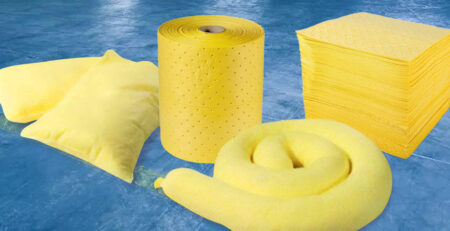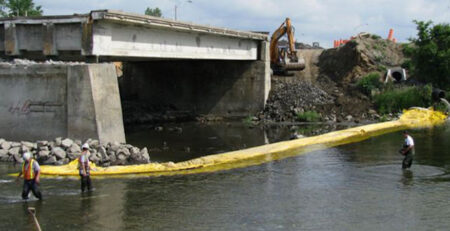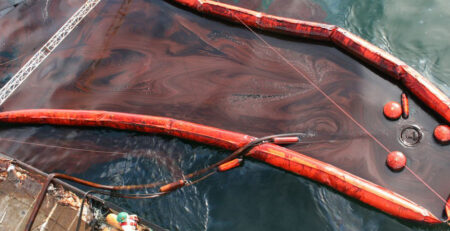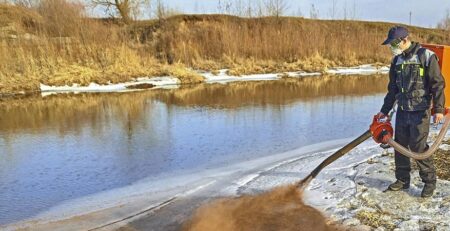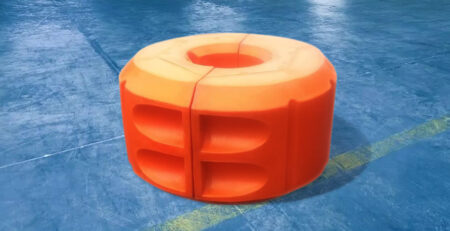Measure seven times
Advertising illusions and real prospects for the use of oil sorbents
From year to year all over the world there is an increase in the number and scale of environmental incidents associated with spills of oil and oil products, which are increasingly polluting our planet. One of the effective ways to prevent and eliminate oil spills is the competent use of oil sorbents. The Russian market of sorbents is just being formed, and this circumstance is often used by unscrupulous companies that easily sell products that are far from the best for their conditions to the buyer. For the correct choice of sorbents, it is necessary to understand their properties, practical possibilities and methods of utilization. An alternative to purchases is the possibility of organizing our own production of sorbents.
In parallel with the growth in the production and consumption of “black gold”, the scale of oil pollution from a variety of sources is also steadily growing (see “Sources of Environmental Pollution with Oil Products”).
“Sources of environmental pollution from petroleum products”
In Russia, oil spills in Komi, in Bashkiria, in the bay of Novorossiysk are widely known, flows of oil products have been flowing for many years from the territory of the warring Chechnya through Dagestan to the Caspian Sea. When oil products are spilled on water, a liter of oil deprives 40 thousand liters of oxygen of water, a ton of oil pollutes 12 km2 of the water surface. The content of oil products in it above 0.1 mg/l gives fish meat an unremovable taste and a specific smell of oil under any technological processing. Oil products in the soil irreversibly inhibit the development of plants at a concentration of more than 2 g per 1 kg of soil (phytotoxicity threshold), there is a delay or complete loss of phenophases in the development of plants, morphological changes in plants, the start of vegetation is delayed by 20-30 days. All this emphasizes the urgency of combating oil pollution.
The scale of the problem corresponds to a set of technical solutions and means for preventing and eliminating oil spills. Not least among them are the so-called oil sorbents – materials that can absorb large quantities of petroleum products, thereby preventing their migration in the environment. They have been widely used abroad for a long time. For Russia, oil sorbents are a relatively new product, so information about them is extremely limited and, as a rule, is of a purely advertising nature. Unfortunately, not only popular, but also special technical literature on the issue of oil sorbents is practically absent. Currently, more than 300 companies in the world produce (or at least claim this possibility) various sorbents, but the most famous on the market are several dozen items.
Where to start?
Before making a decision about the purchase and use of sorbents, it is necessary to answer several questions. The first of them is whether they are needed in this situation? Often, sorbents are expected to solve absolutely all the problems of cleaning the environment, but this is far from being the case. Sorbents are designed for fairly fine stages of purification, as well as where other means are inapplicable for various reasons. For example, if you have a puddle of an oil product half a meter thick, then of course you can pour the sorbent into it, but you can just as well pour the money spent on the sorbent there. It is easier to pump out this layer with a conventional pump or vacuum collector. Layers of oil products on water with a thickness of more than 1 mm are effectively removed by adhesive oil skimmers – skimmers of various designs.
Preliminary treatment of the volume of wastewater can be successfully carried out by sludge, hydrodynamic separation, flotation. It is useless to immediately pour the sorbent onto the oil-soaked soil. The soil itself has some sorption properties, so it will not “give up” the absorbed product to another sorbent without special measures. This is usually a wash with the use of surface-active substances (surfactants).
What to end with?
If you are convinced that the problem cannot be solved with the means at your disposal and it is necessary to purchase a sorbent, then first answer the second question – what to do with the sorbent after the spill has been eliminated, that is, how to dispose of it? Many manufacturers either keep silent about the disposal of the used sorbent, or promise its multiple use and easy disposal in various ways. Practice shows that everything is not so simple.
Firstly, repeated use of the sorbent is possible only when a relatively pure fraction is absorbed by a sorbent with high elasticity. Usually, after two or three spins, the capacity of the sorbent decreases significantly, since its pores become clogged with dirt and heavy fractions, the structure is irreversibly deformed, and again the question of what to do next has to be decided. Secondly, the often recommended burning of the spent sorbent is not applicable to mineral sorbents and, with great reservations, is applicable to synthetic ones, but only in special furnaces at high temperatures in order to avoid the formation of toxic products. Thirdly, the simplest method of disposal – taking the sorbent to a landfill or giving it to road workers – often turns out to be associated with unexpected difficulties, especially in big cities. Almost none of the landfills, which value their license for their activities, will not accept a sorbent with an oil product if it does not have a special technology for its disposal. This is especially true for synthetic sorbents, which, as a rule, are not biodegradable and will lie quietly next to plastic bottles and bags for years – the scourges of modern landfills. Road builders and roofing craftsmen will also not always take your “oiled” mixture without testing. They have their own proven technology, and they will only want to deal with new additives, and those supplied irregularly, even for money, only with great difficulty. The utilization of sorbents from natural organic raw materials is somewhat easier; they can be burned or subjected to accelerated biodegradation with the addition of well-known commercial biological preparations.
After choosing an acceptable disposal method, you can choose the sorbent itself. The main criterion in this case should be the “price/oil intensity” ratio, and to the price of the sorbent it is necessary to add the costs of its delivery, storage, use, removal and the already mentioned disposal. Do not rush to immediately get carried away by the figures of gigantic oil intensity. There are some peculiarities here.
About the subtleties of advertising
Oil absorption capacity (oil capacity) is undoubtedly one of the most important characteristics of oil sorbents. It can be expressed in various ways – as the ratio of the mass of absorbed oil to the mass of the sorbent, as the corresponding ratio of volumes, or as a mixed ratio. It is quite obvious that any porous structure cannot contain a volume of liquid that exceeds the volume of the pores. Even if we take into account some swelling of the sorbent and the possibility of retaining a certain amount of liquid by the outer surface, the volumetric oil capacity of the most highly porous sorbents is close to unity, that is, if you need to remove a cubic meter of oil product, then in any case you need at least a cubic meter of the finished sorbent.
But when using volumetric characteristics, the difference between sorbents in capacity will be expressed in tenths and hundredths, which is unprofitable for advertising. Therefore, without exception, all manufacturers prefer to express capacity in terms of mass ratio. Then, the lighter the sorbent, the greater this ratio, which can reach several tens. These figures amaze the imagination of a potential buyer, and he does not immediately realize that cubic meters, not tons, are important for transporting and storing such a light product. In addition, the sorbent is too light and easily cakes and flies away at the slightest wind.
The next advertising trick is that the absorption capacity is static (maximum) and dynamic (in real conditions). If the first is determined by immersing the sorbent in a pure oil product, then the second depends on the film thickness, the presence of water and a lot of other factors and is usually much lower. Of course, the advertisement indicates the static absorption capacity. Practice shows that when thin films of oil are removed from the water surface, advertising differences between sorbents are very noticeably erased and other indicators come to the fore – cost, buoyancy, ease of use and disposal.
Another marketing ploy is based on the fact that absorption capacity (by mass) is very dependent on the viscosity of the oil product, so it is most often measured on crude oil, and not on gasoline and diesel fuel. Manufacturers, of course, have data on the absorption of various products, but only one is used for advertising, naturally, the maximum. For greater persuasiveness, sometimes a list of “foreign” sorbents is given – supposedly analogues that are not difficult to skillfully select from existing ones, especially since we do not yet publish reference books on sorbents and the consumer is left to rely entirely on advertising.
On the water
After the selection of a number of sorbents that are most acceptable in terms of capacity and utilization, it is necessary to specify the conditions for their planned use. Unscrupulous companies that want to quickly get rid of oil slicks on the water, and at the same time they are not interested in the state of the bottom, use the cheapest mineral sorbents (about 70% of the oil sorbents used in the world are dried highly porous clay). Such sorbents quickly sink with the absorbed oil, hiding the contamination for a while, but little by little the oil rises again (already in smaller volumes). It remains for such dirty tricks to wish a speedy meeting with the environmental inspector. Without fear, these low buoyancy sorbents can be used for oil spills on a hard surface – on asphalt, in an industrial workshop, etc.
On water, it is necessary to use floating sorbents, and the reserve of buoyancy should be sufficient to complete all operations to clean the surface and collect spent sorbent. Buoyancy is determined, as a rule, by the presence of closed pores with trapped air in the sorbent and does not necessarily correspond to hydrophobicity, that is, the water-repellent properties of the sorbent. Even the most hydrophobic synthetic sorbents, along with oil, also absorb moisture associated with the oil film by intermolecular interaction forces.
Special Forces
In addition to the main advantage of quickly and selectively absorbing petroleum products, retaining them for a long time, some types of sorbents may have special properties useful for solving a number of practical problems. For example, biosorbents contain immobilized microbiological cultures, as a result of which the decomposition of petroleum products to their simplest compounds occurs much faster than in nature. It should be taken into account that at temperatures below +50C the reproduction of microorganisms practically stops, so biosorbents are not applicable in winter conditions without special heating. In addition, most of the biological products used require the additional introduction of nutrients other than hydrocarbons into the system – primarily nitrogen, phosphorus and potassium. Biological products act slowly, so you should not expect an instant magical disappearance of all contaminants. However, biodegradation practically solves the issue of recycling sorbents, which significantly simplifies their use.
Sorbents with magnetic properties are convenient for use in hard-to-reach places, as they are easily removed from the water by any magnetic traps on permanent magnets or electromagnets. Sorbents containing surfactants are effective in eliminating very thin films of petroleum products. Some sorbents may contain oil hardeners, which simplifies the collection of contaminants (it should be noted that a number of hardeners are very toxic). The family of sorbents with special properties is rapidly expanding, but any new quality, as a rule, requires additional costs and increases the price of the product.
Additional recommendations
For the practical use of sorbents, it is often important in what form these sorbents are presented – in dispersed (powders, crumbs, granules) or molded (rolled material, mats, napkins, booms). Molded sorbents are more convenient to apply to the surface and clean up, but more difficult to dispose of (they are mostly synthetic). In addition, it is difficult to choose in advance the thickness of the sorbent fabric, which corresponds to an unknown thickness of the oil film. Therefore, the efficiency of using molded sorbents is low. Dispersed sorbents can be applied to the surface in the desired amount, but one has to pay for this with difficulties in spraying and collecting them and put up with the inevitable wind drift in advance (for water use, it is possible to use special schemes for introducing dispersed sorbents from under water).
The use of any sorbents requires a certain minimum of auxiliary equipment. For rolled sorbents, these are drums and squeezing rolls, for dispersed sorbents, pneumatic, mechanical or hydraulic sprayers, various forms of nets and collection nets, and containers for storing the collected conglomerate. In principle, such devices can be manufactured at any enterprise, but this must be done in advance so that the sorbents do not slowly deteriorate in the warehouse. Such equipment is not mass-produced, and many firms with experience in the use of sorbents can give advice on manufacturing.
Different sorbents require different storage conditions – sealed or not, in high or low stacks, and the fire hazard classes of sorbents are also different. Therefore, it is necessary to require recommendations from manufacturers not only on the use, but also on the storage of sorbents.
Without questioning the integrity of the manufacturer of sorbents and the accuracy of advertising, it is still not superfluous to make the simplest tests by purchasing trial batches of two or three different sorbents. In addition, the conditions of mass production can be very different from the experimental ones (on which advertising is based), and, as a result, significant deviations from the approved specifications are possible. When conducting tests, it will become clear what the advertisement was silent about.
Is it really that hard?
Such a question may naturally arise in the Reader when reading this article. No, everything is not as complicated as it seems at first glance, but in order for advertising seductions not to be replaced by disappointment that spreads from the “guilty” sample to the entire glorious tribe of oil sorbents, it is necessary to clearly understand their capabilities. The market for sorbents is just emerging, some brands will gain a foothold in the market, some will be forgotten over time.
But oil rivers and streams do not wait, they must be stopped now and with what is at hand. More precisely, underfoot, since in any region of our vast country there is an almost inexhaustible base for the production of a wide variety of sorbents, and the developers have a set of diverse, often unique production technologies. It is quite possible that there is even no need to carry a sorbent as light as fluff hundreds of kilometers to your own “oil-contaminated” reservoir. Sometimes it’s easier to make your own sorbent from your own raw materials, solve problems with environmentalists, and even help your neighbors at divine rates.
Own production
The authors of the article also have something to share and provide the Reader with the opportunity to verify in practice the effectiveness of the above steps in choosing the optimal sorbent for specific conditions. A number of organizations under the auspices of the Russian Academy of Natural Sciences have developed an affordable and efficient technology for the production of a family of hydrophobic oil sorbents from various raw materials. She received an honorary diploma from the International Ecological Symposium in Las Vegas (USA) in 1997. The main advantage of the technology is its versatility, which makes it possible to master the widest base of raw materials and waste for the production of sorbents. In addition, the developed technology makes it possible to produce sorbents with a variety of properties, including unique ones (for example, magnetic and biological sorbents).
The sorbents produced by this technology have successfully passed a wide variety of tests in various regions, including in winter at air temperatures down to -320C, were used in the elimination of accidents on the Belaya River, on the Moscow-Volga Canal, and are used as a regular tool by many enterprises in Moscow and the Kirov region. Since the technology is reagentless and requires only energy, production can be organized in a short time in any area, which will allow the consumer not only to successfully solve their environmental problems by obtaining sorbents at cost, but also to help neighboring enterprises profitably.
We are confident that domestic oil sorbents have a great future and their widespread use is still constrained both by the lack of sufficiently complete and reliable information, and by a certain imperfection of the regulatory framework. If environmentalists, like firefighters, ordered all enterprises to have a minimum set of certified environmental protection against oil spills, the presence of which can be easily checked, then our lands and rivers would become much cleaner, and sorbents would overtake many of the goods advertised from the screen in popularity. At the same time, the set of sorbents can and should be as diverse as possible, like a set of medicines in medicine. It’s up to the right choice, so as not to scold the pharmacy by taking a laxative for a headache.


